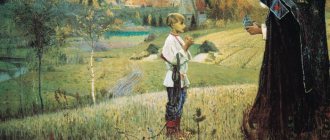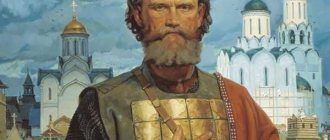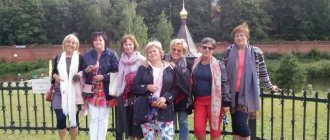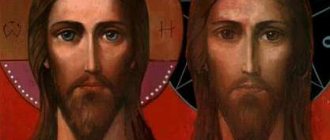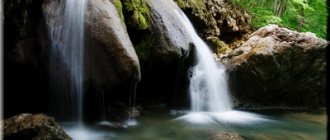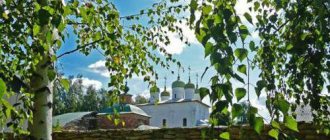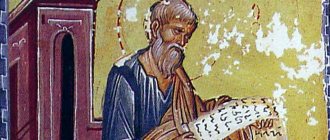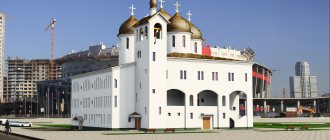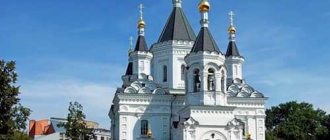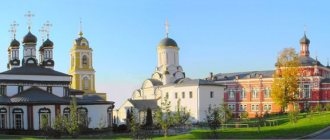History of creation
“The Duel of Peresvet with Chelubey” was painted almost six centuries after the illustrated event - in 1943. Considering the year in which the picture was created, we can confidently speak of parallels between the confrontation with the Tatar-Mongols and the fight against fascism that took place during the creation of the work "The duel between Peresvet and Chelubey." With the common theme of the battle against invaders and oppressors, the picture unites eras and generations separated by many centuries.
However, Avilov seriously thought about the artistic embodiment of this plot in 1917. At the same time, the painting “The Departure of the Tatar Cheli-Bey” was presented. The real work on the work “The Duel of Peresvet with Chelubey” began after Avilov returned to Moscow from evacuation - in 1942. The painting was preceded by four large-scale sketches. Finally, in December of the same year, Avilov finally decided on the composition and completed the canvas in just six months.
The genre of the work “The Duel of Peresvet with Chelubey” can be defined as historical realism. Avilov painted it on canvas with oil paints. The picture reliably reflects the details of the historical costume, harness and weapons - Avilov was especially attentive to these details. At the moment, “The Duel of Peresvet with Chelubey” is stored in St. Petersburg, in the gallery of the State Russian Museum.
Pavel Ryzhenko - hero of art, champion of Holy Rus'
To the 635th anniversary of the Battle of Kulikovo and to the anniversary of the memory of the outstanding contemporary artist Pavel Ryzhenko, who embodied the theme of victory in this decisive battle for the Fatherland in artistic images.
Fleeting time is steadily bringing us, living on earth, closer to Eternity... A year has already passed since the soul of Pavel Ryzhenko, Honored Artist of the Russian Federation, unsurpassed Master of historical painting of the late 20th - early 21st centuries, moved to the eternal abode.
“The hero of the Russian land,” as Pavel’s admirers called him, was born in Kaluga in 1970.
Paul did not come to faith immediately. Afterwards he will say: “Everyone, and especially the Russian person, is drawn in the depths and secrets of his heart to the Light-Christ. Faith in Christ came to me very late, but having believed, I wanted to run after Him, hoping to someday get closer to this Light.”
His grandmother begged him, worried when 16-year-old Pavel, “torn by passions,” returned from the company of his peers. The deeply religious old woman turned to the window and exclaimed: “Queen of Heaven!” Thanks to his crippled grandmother, who survived the war, Paul came to believe in God. “Grandmother is a bridge to that Russia, to Russia, where there was no phrase: “Your problems!” said Pavel. Paul was baptized only at the age of 23 and then wanted to go to a monastery. For some time he carried out obediences at the Valaam metochion in Priozerye, but he realized that his path was not a monastic one. For him, his own family became the “guarantee of heaven” on earth, and the artist tried to raise his son Tikhon as a subject of the coming king.
Pavel began drawing at the age of five; at the age of 11 he became a student at the Moscow Secondary Art School (MSHS) at the Institute named after. Surikov, and in 1990, after military service, as a student at the Russian Academy of Painting, Sculpture and Architecture. Here Ryzhenko met with the venerable painting professor Ilya Glazunov, who built a strict hierarchy of values for his students. Ryzhenko said about his great teacher: “This is a fragment of pre-revolutionary Russia, a nobleman, an outstanding bearer of a bygone culture.” Pavel believed that art should not strive to “overtake and surpass” the avant-garde with its ultra-modern style of painting, and painting needs to return to the mainstream of “humble antiquity,” academic canons. Ryzhenko’s first serious thoughts about appointing an artist arose while still at the Academy. He recalled his studies as the happiest years of his life. “I remember the delight that first gripped me in the halls of the Hermitage in front of the paintings of Rembrandt, Van Dyck, Vermeer... It seemed that all these great masters were present here, next to me. I felt the breath of living history, the greatness of powerful Empires - Byzantium, Rome, the Russian Empire. I felt the coolness of the Sinai desert and the smell of gunpowder smoke over Borodino; the stern faces of Russian warriors, fearless and invincible, stood before me.”
Pavel defended his thesis “Kalka” in 1996. Abandoning the previously chosen topics, he locked himself in his small workshop and plunged into work, not even going out for viewings. He was fascinated by the idea of writing a canvas about Rus', fragmented into principalities, drenched in blood, but not conquered. And he created a piercing picture of the terrible defeat of the proud Mstislav the Udal and Russian warriors in 1223 at the Kalka River, in the territory of the present Donetsk region. The surviving Russians were thrown by the ferocious Mongols under the flooring for feasting. The climax of the picture is Prince Mstislav’s awareness of his monstrous mistake, bound with ropes, as if by sins, he begins to understand that the defeat of the Russians is caused by the fragmentation of Rus' and his personal sins - vanity and pride. “God resists the proud, but gives grace to the humble.” The Russian princes had to learn humility and the Tatar-Mongols helped them with this. The sky in the picture is clear, Mstislav peers into the distance, as if he sees the coming victory and glory of Rus'-Russia.
Ryzhenko Pavel “Oslyabya” 2005
Pavel said that many talented children who showed great promise studied with him. He believed that “their educational works could safely be hung in the Tretyakov Gallery - next to the paintings of Surikov and Repin. Why did most of them never rise to real art? If an artist is not rooted in Orthodoxy, he does not have lasting immunity against vanity, love of money and other passions leading to personality degradation and loss of moral guidelines. “There’s a nonentity riding in a jeep,” said Pavel, “he “packed” himself, he’s so important and accomplished. He really doesn’t like to be told anything “against the grain.” No criticism! And the same can be said not only about artists - and about doctors and scientists. This is everywhere... This, it seems to me, is the tragedy of Russia today.” According to Pavel, the history of art knows very talented artists who devoted their lives to awakening passions in people. If the artist treated his work as a service, and not a way to earn money, if he “did his work with the utmost honesty and was in harmony with God and conscience, he could receive a greater reward for his work. There is no need to blame either the authorities, or sponsors, or their presence or absence. We need to start an honest conversation with ourselves.”
Pavel also had crises in his life. At one time the artist was very depressed due to financial difficulties. But by the Providence of God, he met with Archpriest Artemy Vladimirov, who returned the artist’s “second” creative wind, becoming his confessor. Pavel came to the realization that “service to art is inseparable from the religious principle, from the foundations, from deep culture.” For Ryzhenko, creativity became an “outburst of mental state” and a confession on canvas; without advertising his exhibitions, he waited for those whom God would send him. “The One who gave me the opportunity to write all this has His own plan about which people to bring to the exhibition. Piece by piece. Exactly." At Ryzhenko’s exhibitions in the Central Museum of the Armed Forces, the Central House of Artists and the Manege, queues of 300 people lined up for tickets... Like St. Prince Alexander Nevsky, Pavel Ryzhenko did an extraordinary amount in his 43 years of life. He seemed to be in a hurry to do everything, to please God, he burned out in his labors like a candle, unable to work at half strength. Over the 20 years of his intense creative life, Pavel Ryzhenko created 60 grandiose canvases in the best traditions of Russian realism, painted 6 dioramas, collaborating with the Studio of Military Artists M.B. Grekova, tried to instill a truly artistic taste in students of the Academy of Painting during his teaching at the composition department. The works of Pavel Ryzhenko in terms of skill and technique, colors, multi-figures and versatility, and, most importantly, adherence to the “Russian Orthodox idea” are quite comparable to the works of brilliant painters of the late 19th - early 20th centuries - I.E. Repin, V.A. Serova, V.I. Surikova, V.V. Vereshchagina, V.M. Vasnetsova.
Ryzhenko Pavel “Prayer of Peresvet” 2005
“Terrible events are happening in culture,” the artist complained bitterly. “The avant-garde has already become a “classic,” that is, mental disorder has become a classic...” Pavel wrote about his work that it is “an alternative to avant-garde art. Timid resistance to Chagall, Malevich with his Square... My task, as an artist, a weak person, with the help of God, is to stand in the way of this stream of dead water. And resist this flow. I identify myself not with a pan-European, pan-human culture, but with a culture whose threads stretch from the apostolic centuries, through Byzantium to Rus'.”
The unbridled pseudo-art of the 20th – 21st centuries. Pavel contrasted the beauty and grace of the academic style of writing, borrowed from his teacher-professor I.S. Glazunov and academic artists.
Ryzhenko realized that in 1917 the Russian Empire was dragged into the abyss of godless ideas by structures aligned with the West, and the country lost its way from its historical destiny. At the same time, the patriotic artist fervently believed that Russia would rise from sleep, shake off the enemy’s obsession and once again return to its great mission of the Successor of Byzantium, the stronghold of Orthodoxy over a vast territory and would lead other nations to salvation.
In recent years, Ryzhenko, with the observant eye of an artist, has noticed signs of recovery taking place in Russian society. “I am against presidential power, but I am personally for Putin! - said Pavel. – Putin is a person who loves and understands Russia and, through the prayers of the Russian people, is self-developing. Having gained enormous life and political experience, he became our commander, but not our president. He has outgrown the presidency. People trust him and know that they can rely on him to deliver. Where? I am convinced - to the Empire, to the Orthodox Empire, which will unite - and not divide! - our peoples."
Pavel Ryzhenko's service to the Fatherland and fine arts is that through a series of monumental canvases he consistently recreated the history of Holy Rus' and the Russian Empire, as two interconnected hypostases of a single whole - the Russian Orthodox Civilization. The artist painted “deeds of bygone days” from the very beginnings of Rus' to the tragic collapse of the Russian autocracy in 1917, which, however, he saw as the seeds of its future revival - through the prayers of the murdered Royal Family and the Russian new martyrs. Ryzhenko, generously endowed with multifaceted talents from God, rose above the realities of our time with hope for the future unity of Holy Rus', the Pleasers of God and the entire Orthodox people, on the one hand, and the Russian State with its imperial power, on the other hand. Paul expected the awakening of the Russian people, their return to the saving meanings of Orthodoxy, and with his works, many of which are now perceived almost as icons, he contributed to this, created according to certain canons, which brought him closer to icon painting. Landscape artist Oleg Molchanov calls his friend Pavel Ryzhenko “the hero of painting.” This is the heroism of a working artist who touched upon the most intimate themes, of which there are no number: the Baptism of Prince Vladimir, Russian saints, kings and generals, Russian Athos, simpletons, historical battles, royal Golgotha, churches and monasteries, the First World War, the Great Patriotic War, landscapes... Paul set himself the goal of awakening the human soul, making it desire “quiet exploits” and climbing the ladder of virtues to the ability to “lay down one’s life for one’s friends.” Having become like the schema-monk-hero Peresvet, whose military and spiritual feat Pavel Ryzhenko extolled in the masterpiece painting “Victory of Peresvet,” the artist himself fought a battle all his life. Only Peresvet defeated Chelubey on the Kulikovo field, and Pavel Ryzhenko fought a heroic battle for the purity of art and Holy Orthodoxy. Pavel dedicated the diptych “Prayer of Peresvet” - “Victory of Peresvet” to the historical battle of the hero Peresvet with Chelubey. Both pictures are organically connected: without the incessant Jesus Prayer there would have been no victory over the formidable Chelubey, the best warrior in Asia, who is still prayed to as a saint in Tibet. Pavel considered the most important thing in the painting “The Prayer of Alexander Peresvet” to be the look of the schema-monk hero, who learned from St. Sergius that he would soon have to fulfill the most difficult, life-saving obedience - to gain glory for the Russian soldiers on the Kulikovo field and “lay down his soul for his friends.” . Schemamonk Alexander prays detachedly before his birth in Eternity. Nearby, according to Paul, “a hedgehog rustled,” who was not at all afraid of the hero, and this is an indication of the spiritual transformation of the schema-hero. “Like Gerasim of Jordan with a lion, so is Peresvet with a hedgehog,” notes Ryzhenko’s widow, Anastasia, who became the guardian of his artistic heritage. Many monastics, including those on Mount Athos, have paper reproductions of this painting in their cells. Some time ago, the image of Peresvet became myrrh for the Lavra elder Naum...
Ryzhenko Pavel “Victory of Peresvet” 2005
Pavel developed the theme of the Battle of Kulikovo for 10 years, deeply comprehending it, carefully studying history before creating his masterpiece. Pavel went to Kulikovo Field several times to inspect the area. The Moscow prince Dimitri Donskoy, blessed by St. Sergius for the decisive battle on the Kulikovo field, gathered an army with great effort. The entire treasury was given to the soldiers, of whom only a fifth returned alive after the battle. The battle took place “on the Don at the mouth of Nepryadva” - the forces of Prince Dimitri Ivanovich and the Golden Horde Khan Mamai met in the hilly steppe of the Oka-Don interfluve. Nowadays the Kulikovo field, as an extended geographical object, belongs to Efremovsky, Plavsky, Bogoroditsky and some other districts of the Tula region. It is known that the Mongol-Tatar army was defeated largely due to the unexpected attack of the Ambush Regiment under the command of Vladimir Serpukhovsky and governor Dmitry Bobrok-Volynsky.
The theme of repentance is a cross-cutting theme for Ryzhenko’s work; it is clearly represented in the Triptych “Repentance”. In the first painting, “The Strike of the Bell,” we see a Red Army soldier participating in the battles for the monastery, and accidentally touching the rope of the bell, which suddenly began to sound and filled the wounded soul from childhood with familiar sounds. Perhaps it was he and his “comrades” who, at the height of revolutionary fervor, once threw down bells from churches. Here the red commander first realizes the enormity of his crime and the bitter absurdity of the fratricidal war. In the second painting, “Wreath,” he visits his wife’s grave and waters it with tears. The only thing that can console a grieving soul is unity with God. In the third painting “Anthill” this man appears to us already transformed by a long path of repentance and prayer. Now he is a wandering monk, with the enlightened face of Seraphim of Sarov. The old man sits down to rest by an anthill in the forest, contemplating the beauty of God’s world and the harmony in nature, including in the “ant hierarchy.” The life of ants is orderly: everyone bears his own “obedience”, and there are no wars or revolutions in the anthill... The elder has long been reconciled with God: the past is washed with tears, and his repentance is accepted.
In recent years, the royal theme has become central to Pavel’s work. He paints many paintings depicting the martyr Tsar Nicholas II and the Royal Family at different moments in his life. In the words of Archpriest Artemy Vladimirov, Pavel sought and found himself a “Helmsman” in the person of the Tsar.
Before painting “The Royal Golgotha” in 2002, Ryzhenko traveled to Yekaterinburg, prayed at Ganina Pit, where he had a vision of sketches of the painting, which he transferred to canvases. According to the artist, “The Emperor is an example of defending the faith and an example of incredible sacrificial love, he is the father of his people who renounced them...”
Shortly before his death, Pavel worked with all his might on a large-scale diorama “Standing on the Ugra” for the Vladimir monastery of the Kaluga St. Tikhon Hermitage. Having visited the diorama, His Holiness Patriarch Kirill said: “The wonderful diorama of Pavel Ryzhenko is his swan song. He left us early, full of strength and creative energy, opening a special page in the history of Russian art... Everyone who comes here will remember the historical feat of the people, the creator of the diorama and the decorator of this holy place.”
It is providential that Pavel Ryzhenko left us on the night of July 16-17, 2014, on the day of remembrance of the Holy Royal Martyrs, whom he so reverently revered, and the funeral service took place on July 20, after the Council of Radonezh Saints and the discovery of the honorable relics of St. Sergius of Radonezh, whose image Ryzhenko painted often and reverently. The artist once said about the purpose of his work: “I hope that my paintings will awaken the genetic memory of my contemporaries, pride in their Fatherland, and perhaps help the viewer find the only right path for themselves. And then I will be happy with my duty fulfilled.”
Valeria Svyatkina, graduate of Higher Theological Courses
Author
Mikhail Ivanovich Avilov (b. 1882 – d. 1954) was a Russian and Soviet artist who worked mostly in the genre of historical painting. He was born in St. Petersburg. In his artistic education, Avilov went through the following stages:
- From 1893 he studied at the Drawing School of the Imperial College of Arts.
- In 1903 he entered further studies at the Dmitriev-Kavkazsky studio.
- In 1904, Avilov became a volunteer student in classes at the Higher Art School at the Academy of Arts.
Already during the years of listening to a lecture at the Academy, the artist began working on canvases in the historical genre. In 1914, Avilov went to the front of the First World War. After the Revolution, the artist became a teacher at a school at the Society for the Encouragement of Arts, then at the Leningrad Art and Industrial College. 1923 Joins the Association of Artists of Revolutionary Russia.
After the Second World War, Avilov became a member of the USSR Academy of Arts and a teacher at the Leningrad Institute. Repina. With the beginning of the Second World War, the artist was evacuated to Uzbekistan, where work began on the canvas “Duel of Peresvet with Chelubey. In 1953 he was awarded the title of People's Artist of the USSR. A year later, Avilov died and was buried in St. Petersburg, at the Tikhvin cemetery.
Reproductions
Dear friends!
Reproductions are made by the copyright holder in the person of the artist’s widow, Anastasia Yuryevna Maksimova-Ryzhenko, using digital images of paintings of the highest quality, available only to the copyright holder.
Any other products are low-quality and counterfeit, completely not reflecting the color and tonal range of the original works of Pavel Ryzhenko. In addition to the dubious quality and possible danger to your health (illegal workshops use, in order to save money, solvent technology, which is prohibited for interior printing), counterfeit products violate federal copyright law.
Reproductions are printed on canvas, stretched on a stretcher, framed and equipped with a metal cable on the reverse side.
All reproductions are accompanied by an annotation telling about a particular historical event or character in the picture. The presence of an annotation confirms the authenticity of the reproduction you are purchasing.
Printing is done with environmentally friendly pigment ink on a wide-format 10-color EPSON Stylus Pro 9900 plotter, using only original consumables. For the production of framing frames, equipment from Italian and French companies OMGA, Cassese and MORSO is used.
The frame is included in the price of the reproduction!
You can choose a reproduction that suits you in terms of format and cost in the table below.
Attention! The formats are given without taking into account the frame size. To get an idea of the final size of the painting, you need to add 5-8 cm on each side, depending on the baguette you choose. We send photographs of baguette options for approval by e-mail during the ordering process.
How to order reproductions:
- call tel. Dmitry, or write to the same number on Whats App
- write to e-mail: pvrgal [email protected]
When ordering three reproductions of the same format at the same time, the following discounts are provided:
- A4 format – 5%
- A3 format - 5%
- A2 format – 10%
- A1 format – 10%
- A0 format - 10%
- A0+ format - 10%
- When ordering ten or more reproductions of the same format at the same time, a 20% discount is provided.
Delivery methods:
- pickup in Moscow
- transport
Reproductions of paintings by Pavel Ryzhenko can be a wonderful gift that promotes education in the field of history, culture and art. And also to support our activities to preserve the paintings of an outstanding artist, which we carry out only on our own.
Description of the composition
“The Duel of Peresvet with Chelubey” is distinguished by its large dimensions - 327x557. In the foreground, the painting depicts two fighting warriors: horses rearing, shields raised, spears pointed at each other. Behind them are armies. The atmosphere on the canvas is alarming and tense. Avilov used natural, slightly muted tones in this picture:
- Green.
- Grey.
- Beige.
- Golden.
- Pale red.
- Black.
At the same time, it is noticeable that the Tatar-Mongol army is depicted in a more colorful way, as well as the horseman representing it. With this technique, the picture emphasizes, firstly, the exoticism of their appearance, and secondly, the confusion that gripped people. At the same time, the Russian army looks more calm and harmonious. The only bright spot on this side of the canvas “The Duel of Peresvet with Chelubey” is the banner with the face of the saint. It personifies the people’s struggle for spiritual values and faith in the justice and righteousness of their actions, which distinguishes them from the enemy.
Login to the site
Recently, in one of the bookstores of the Trinity-Sergius Lavra, I came across reproductions of paintings by Pavel Ryzhenko. Severe and beautiful, epic Holy Rus' on the canvases of this artist. At first glance, these are Vasnetsov’s traditions in a modern interpretation. The fairy tale acquired the realism characteristic of modern art. Tragic pages of Russian history, heroes going to their deaths. Feat and defeat. Holiness and cruelty.
Pavel Ryzhenko “The Blessing of Sergius”
St. Sergius blesses Dimitri Ivanovich Donskoy for the Battle of Kulikovo. What a difficult subject for a painting after the canvases already painted before you! I really wanted to portray the essence. Just the gist and nothing more. It seemed to me that the monk simply gathered these stern, weather-beaten people going to death, and embraced them with his heart. And it was so warm and quiet, as if the victory had already been achieved and everyone had returned alive... As if he, Sergius, would not have to call out loud at the liturgy the names of the heroes at that moment leaving for Paradise from the blood-smoking field of Kulikov.
And Sergius quietly whispers to Dimitri, but not yet to Donskoy: “You will win!”
Pavle Ryzhenko “Battle of the Neva”
The Battle of the Neva took place on July 15, 1240 on the Neva River between the Novgorod militia under the command of Prince Alexander Yaroslavich of Novgorod and the numerically superior Swedish conquerors. Alexander Yaroslavich received the honorary name “Nevsky” for victory and personal courage in battle. Having defeated the Swedes, Russian troops stopped their advance to Ladoga and Novgorod and thereby prevented the danger of coordinated actions of Sweden and the Livonian Order against Rus'.
Prince Alexander Nevsky canonized by the Russian Orthodox Church in the ranks of the faithful under Metropolitan Macarius at the Moscow Council of 1547
Pavel Ryzhenko "Oslyabya"
It’s a quiet morning, permeated by the rays of the warm sun, apple trees are blooming, beehives are visible behind the monk’s back. But the main thing in this little picture is that the monk’s name is Oslyabya.
And this monk is preparing not to whiten the trunks, but to give his life - for Christ and for all the Russian people he loved, including for you and me.
He leaned his heavy hand on a tree and thought. My whole life passed before my mind's eye. He, Oslyabya, is ready. He - the warrior of Christ - will nevertheless whiten his apple trees, and then, taking a sword, rush into the very hell of the Battle of Kulikovo to beat the enemies of God and lay their corpses in sheaves, and then be cut down himself along with his great brother Peresvet.
Pavel Ryzhenko “Prayer of Peresvet”
Sergius of Radonezh blessed Peresvet for the Battle of Kulikovo. Another name of the painting is “Prayer before the battle.”
The most important thing here is Peresavet’s eyes, his gaze. This is why I painted the picture. There is hardly any need to explain anything here for a long time.
I did not want to artificially create any special atmosphere in order to convey the mood of the indescribable world of this saint. So he prayed before his birth into Eternity. He broke a piece of bread. A hedgehog rustled past... All this is Russia. I wrote as I felt - it’s not up to me to decide what happened, but that’s not the main thing. The main thing is that everyone has their own meeting in the depths of their hearts with Peresvet and with themselves.
Pavel Ryzhenko “The Quietest”
Tsar Alexei Mikhailovich Quiet , the father of the first Russian Emperor Peter I, is the last sovereign of the so-called “pre-Petrine” time. It is generally accepted that this time is dark, ignorant, and the Sovereigns are considered almost fabulous old bearded men. But they weren't really like that.
Not fussiness, passed off as excessive efficiency, but prayerful peace and strength were characteristic of these giants of spirit.
These were not chosen by the crowd and money, but anointed ones appointed by God. No wonder Alexey Mikhailovich was called the Quietest by the people. In this naming one feels both filial love and recognition of the power of the royal service, which, like any true power, is always quiet like the ocean.
Pavel Ryzhenko “photo for memory”
Triptych “Russian Century”
This work, consisting of three paintings, is united by a common thought and feeling - loss, forgiveness and bright sadness for the great Russian Family, headed by the Sovereign Emperor, anointed to the kingdom in the name of Christ.
Anointed - that is, having from God the right to judge and protect his people entrusted to him.
These are pictures about the Russian officers who made their way to Golgotha - from the Borodino celebrations (at) to the funeral of shoulder straps in the hope of opening them someday and serving Russia (“Tsar’s Epaulets”) and, finally, to the cold capter in France, where Russian officers celebrate Orthodox Easter far from their homeland.
Pavel Ryzhenko “Strike of the Bell”
The sound of the bell (No. 1 Triptych “Repentance”)
A lonely person in the world. No earthly joy, no glory or power pleases him. But he becomes free and majestic when he subordinates his desires to a single love for the One Christ. And then, having met Him, a person forgets everything and only cries, and his tears do not choke him, but wash his soul.
Pavel Ryzhenko “Anthill”
Anthill (No. 3 Triptych “Repentance”)
The triptych “Repentance” is about the fate of a Bolshevik, who from a simple soldier of the revolution becomes a division commander, and from a division commander - through the grief of loss and rethinking his life - into an elder monk.
The first time his soul trembled was when he accidentally touched the rope stretching to the bell (“Blow of the Bell”). The second time - in front of the cross over his wife’s grave, after a bloody victory over his brothers in civilian life (“Venochek”). And here, finally, is the result: the old man paused in heavy thoughts and sat down by the anthill. He looked at his life with sadness and sighed quietly in the hope of forgiveness...
Pavel Ryzhenko “Farewell to the convoy”
Farewell to the convoy (No. 1 Triptych “Royal Golgotha”) Can a person who, blinded by anger, kill his father, be happy, being in peace and prosperity? Our entire people, to which I count myself, are still in great numbers involved in the sin of parricide. But not only the father of the people, the tsar, was killed, his innocent children and his wife, the empress, were also killed. Now that the truth about the origins of our current misfortune—the regicide—is open and accessible, we cannot escape with ignorance.
Pavel Ryzhenko “Alexandrovsky Palace”
Alexander Garden. Imprisonment (No. 2 Triptych “Royal Golgotha”) We suffer, but why don’t we go to repentance, don’t ask for forgiveness? After all, forgiveness follows the correction of our lives.
The Apostle Peter, who betrayed Christ, also suffered. Already forgiven by him, he did not forgive himself and at the morning rooster crowed he sobbed inconsolably over himself.
Pavel Ryzhenko “Ipatiev House. Execution"
Ipatievsky house. Execution. (No. 3 Triptych “Royal Golgotha”)
This sin of ours is like a disease driven deep into the depths; it cannot be forgotten, but we must honestly admit it and try to atone for it with Christ’s help.
_
2012, February
source: pavel-ryzhenko.rf
What did the author want to say?
The painting “The Duel of Peresvet with Chelubey” symbolizes, first of all, the victory of light over darkness, the liberation movement over the invaders. At the time when the canvas was created, in 1943, people desperately needed such subjects. The painting was completed at the time of the battle for Stalingrad - Avilov transferred the tension from this difficult period and the silent hope for a successful outcome into his “Duel of Peresvet with Chelubey.”
The picture conveys the urgency of the fight against evil through one symbolic gesture - the hero pierces the image of a snake on the enemy’s shield with his spear. The snake is the personification of the evil principle. Another important point pointed out by the painting “Duel of Peresvet with Chelubey” is the difference in the formation and poses of the warriors in the background. The Russians stand calmly, strictly holding formation, raising banners above their heads. In front, Avilov portrayed Dmitry Donskoy. Among the Tatar-Mongols, the order is broken, their poses express confusion and uncertainty. All this foreshadows the outcome of the battle in advance - the “Duel of Peresvet with Chelubey” will end with the defeat of the invader, after which the yoke will be ended forever.
The duel between Peresvet and Chelubey in paintings by Russian artists
This significant moment in Russian history was depicted not only by Avilov in his works. The fight between Peresvet and Chelubey served as inspiration for many famous and unknown painters. The first painting known today is an ancient supplement to the icon, painted by masters of the Arkhangelsk school, according to researchers, in the 1680s. It shows the battle between Peresvet and Chelubey and other key scenes of the historical battle.
Interest in the Battle of Kulikovo awoke in the 19th century. However, the paintings painted during this period are mostly dedicated to Dmitry Donskoy. The duel between Peresvet and Chelubey, as a reflection of the people's struggle, became a motif in painting in the first half of the 20th century.
The first painting, “The Duel of Peresvet with Chelubey,” was painted in 1914, also during the war – only the First World War. Its author is Vasnetsov. His painting, close in composition to the one painted by Avilov, is less realistic - “The Duel of Peresvet with Chelubey” resembles an illustration from a book. Another important difference is the clothes and equipment of the hero, which clearly refer to the version that he was a schema monk. Avilov, creating his “Duel of Peresvet with Chelubey,” abandoned this motive.
The truth about the fight between Peresvet and Chelubey
Recently, during an interview with His Holiness the Patriarch, I noticed a painting hanging in his reception room. This was the original of Pavel Ryzhenko’s painting “Victory of Peresvet”. The canvas depicts the famous fight between the invincible Tatar-Mongol hero Chelubey and our Alexander Peresvet, a monk who, with the special blessing of St. Sergius of Radonezh, went out with his brother Andrei Oslyabey to battle on the Kulikovo field.
The great wisdom and insight of the remarkable Russian saint, St. Sergius, was manifested in the very essence of this fight. It was a battle between the forces of light and the forces of darkness. And this is not a figurative expression at all, but the very essence of the events that occurred on September 8, 1380.
When we stood in front of this picture, one of the abbots of the Trinity-Sergius Lavra told us the following story. There is a monk in the monastery who, in his youth, like many then, was fascinated by Eastern spiritual traditions and martial arts. When perestroika began, he and his friends decided to go to Tibet to enter some Buddhist monastery. Since 1984, when the monasteries of Tibet were opened for access, albeit with limited quotas, many foreigners began to come there. And it must be said frankly that the attitude towards foreigners in the monasteries was extremely bad: after all, this is Tibetan national spirituality. Our future monk and his friends were disappointed: they were so eager for this sublime teaching, for this brotherhood, spiritual exploits, mantras and prayers. This attitude continued until the Tibetans learned that they were facing Russians. They began to talk among themselves, and the word “Peresvet” was heard in the conversation. They began to find out, and it turned out that the name of this Russian monk was written in a special holy book, where their most important spiritual events were recorded. The victory of Peresvet is listed there as an event that fell out of the usual course of things.
It turns out that Chelubey was not just an experienced warrior and hero - he was a Tibetan monk who was trained not only in the Tibetan martial arts system, but also mastered the ancient practice of martial magic - Bon-po. As a result, he reached the heights of this initiation and achieved the status of “immortal.” The phrase “Bon-po” can be translated as “school of combat magic speech,” that is, the art of fighting in which the effectiveness of fighting techniques increases infinitely by attracting the power of powerful entities of the other world - demons (demons) through magical spells. As a result, a person allows into himself the “power of the beast”, or, more simply put, turns into a single being with the demon, a kind of symbiosis of man and demon, becoming possessed. The payment for such a service is the immortal soul of a person, which even after death will not be able to free itself from these terrible posthumous embraces of the forces of darkness.
It was believed that such a warrior monk was practically invincible. The number of such Tibetan warriors chosen by spirits has always been extremely small; they were considered a special phenomenon in the spiritual practice of Tibet. That is why Chelubey was put up for single combat with Peresvet - in order to spiritually break the Russians even before the start of the battle.
In the famous painting by V. M. Vasnetsov, both warriors are depicted in armor, which distorts the deep meaning of what was happening. Pavel Ryzhenko wrote this story more accurately: Peresvet went into battle without armor - in the vestments of a Russian monk of the great schema and with a spear in his hand. Therefore, he himself received a serious wound from Chelubey. But he killed the “immortal”. This caused complete confusion for the Tatar army: something happened before their eyes that, in principle, could not happen. The usual course of things was disrupted and the immutable laws of the pagan world were shaken.
And to this day, servants of the spirits of darkness, masters of martial arts, keep the memory that there are certain “Russians” who have their own God, whose power is irresistible. And this Russian God is higher than all their gods, and the warriors of this God are invincible.
